I don’t have much to say about 1981. Plenty of dramatic events occurred in that year (most notably the attempted assassination of President Ronald Regan), but I was too young to take much notice of them. The things I do recall are decidedly less auspicious. They include the thrill of seeing my first-ever horror movie in a theater (SATURDAY THE 14th), taking in another movie (TIME BANDITS) that introduced me to concepts like dream logic and surrealism, and another (CLASH OF THE TITANS) that provided me with an early taste of goofy monster movie mayhem, with psychic fallout that in all three cases has proven extremely long-lasting.
None of those movies will be included in the following ranking, which as always with my Year in Bedlam overviews features thirty overlooked and obscure film releases from the year in question. The ranking is from least to best, although I feel all of these films are worth viewing, difficult to locate though some-okay, most—of them are.
30. AMIN: THE RISE AND FALL
The reign of the notorious Urgandan despot Idi Amin (profiled in Barbet Schroeder’s 1974 IDI AMIN DADA: A SELF PORTRAIT) contains more than enough material for an exploitation epic, and this one doesn’t disappoint: among other outrages, AMIN: THE RISE AND FALL contains severed heads in a freezer, mass executions, rape, group sex and even cannibalism. The late Joseph Olita (1944–2014) is simply great in the main role, and anyone familiar with Schroeder’s film can see that Olita replicated Amin’s look and mannerisms perfectly. Considerably less impressive is the filmmaking, which never rises above that of a run-of-the-mill TV movie. But again, Olita is damned impressive, enough so to make me regretful that, outside of a few small roles in movies like SHEENA (1984) and MISSISSIPPI MASALA (1991), he didn’t do much else.
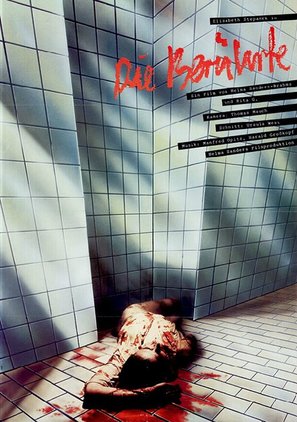 29. NO MERCY, NO FUTURE (DIE BERUHRTE)
29. NO MERCY, NO FUTURE (DIE BERUHRTE)
A bleak and unforgiving German-centric portrayal of madness, notable for its uncompromising realism. It was inspired by actual letters from a schizophrenic woman, identified only as Rita G., whose dialogue and situations were apparently transferred verbatim to the screen. Rita’s exploits include stripping naked in snow and lying down with her arms splayed out cross-like before the Berlin wall. Her other schizophrenic quirks, all of which seem geared to scandalize her ultra-refined relatives, include a succession of illicit affairs with various men and sending all the money her parents give her to the Pope. Occasionally director Helma Sander-Brahms visualizes Rita’s delusions (hands sprouting from the ground, a window reflection replaced by a flaming cross), but for the most part all we’re shown is a near-documentary depiction of eighties-era Berlin at its most depressing. What makes it work is the amazing performance of Elisabeth Stepanek. Hers is a bold and unfettered piece of acting, spiced with near-constant nudity and one of the most disgusting sex scenes—in which she and her partner are literally covered in vaginal blood—in film history.
28. THE KILLING OF AMERICA
Essentially a self-important FACES OF DEATH that purports to explore America’s late Twentieth Century decline. This entails a succession of verite scenes of people getting killed, including footage of the JFK assassination and the shooting of Ronald Reagan, which are often played repeatedly in slow-motion to make absolutely sure we get all the gruesome details. Highlighted are the many high-profile assassinations of the 1960s and the notorious serial killers of the 70s, all described in loving detail by narrator Chuck Riley. Co-scripted by the late Leonard Schrader, the film exerts a definite geek show fascination, and, trite though its conclusions may be, does make a valid point about America’s increasingly violent and unstable populace. That latter fact becomes particularly evident when looking back on the film, with the early 1980s, a time THE KILLING OF AMERICA views as a blood-soaked free-for-all, seeming downright idyllic compared with how things are now.
27. BEING DIFFERENT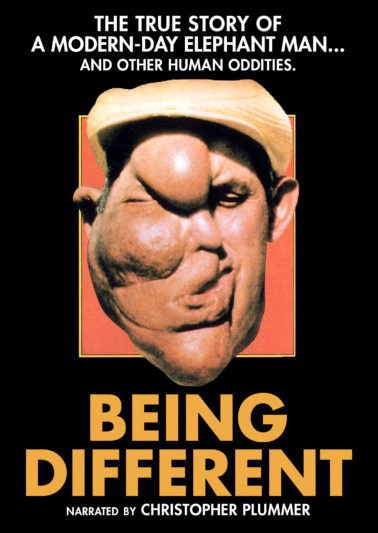
I’m always up for a good “special people” documentary, which BEING DIFFERENT most definitely is. It lets us into the lives of several human oddities, including the world’s “fattest” man (at seven hundred-something pounds—obviously his title has since been usurped), the world’s tallest woman, a guy with the “Elephant Man disease,” the Monkey Girl, the Alligator Man and many others, all of whom take pains stress the normalcy of their lives and steadfast refusal to succumb to self-pity. It’s tied together by shamelessly histrionic narration by Christopher Plummer (“They must live in our world and we in theirs!”) and laughably tacky seventies muzak. The best parts are the vignettes showing the film’s subjects at work and play; particularly unforgettable is the sight of an armless woman driving a car and putting on clothes with her feet, a club footed man running on his stumps, and an interview with the sorely missed, perpetually cheerful Billy Barty.
26. SURFACING
An irresistible blast of bad movie fun! Back in 1971 the late Claude Jutra made what is often proclaimed the greatest Canadian film of all time, MON ONCLE ANTOINE, but apparently lost his mind when he directed this Margaret Atwood-based pretension-fest. It features a young woman (Kathleen Beller) travelling to the Alaskan wilderness in search of her father, who has disappeared somewhere in the region. She makes the mistake of bringing along a gal pal and two horny guys, all of whom go completely bonkers by the time the trip is done. They meet a sadistic hunter who one of Beller’s companions humiliates at gunpoint by forcing him to piss his pants. Later on another of the guys tries to rape the heroine after reciting a lengthy monologue about a childhood encounter with a cat, and then forces the group’s other woman to dance naked around the carcass of dead bird. It’s all just as ludicrous as it sounds, with the capper coming at the very end, when Beller comes to the profound realization that “I’m tired of focusing on death…there’s life growing all around me!”
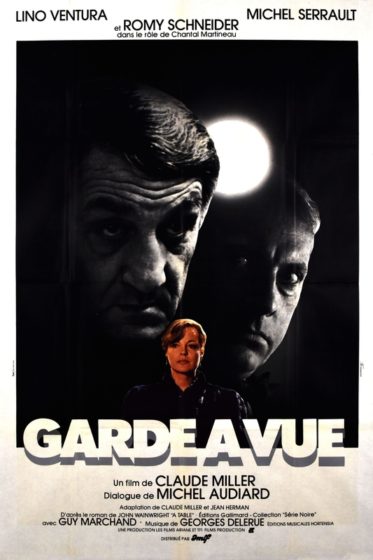 25. THE GRILLING (GARDE A VUE)
25. THE GRILLING (GARDE A VUE)
Contrary to what you may have heard, this French thriller is not a “masterpiece.” It is, however, pretty damn good, being the forerunner of the minimalistic interrogation movie trope that includes THE DEATHMAKER (1995), THE INTERVIEW (1998) and UNDER SUSPICION (2000), the Hollywood remake of the present film (a VERY rare example of an American redo that’s more arty and inscrutable than the French original). THE GRILLING was directed, unfortunately enough, by Claude Miller, a skilled but unexceptional helmer—and an exceptional director is what this material, adapted from a novel by John Wainwright, needed. At least Miller was smart enough to stay out of the way of his lead actors, who include Lino Ventura as a dogged police inspector and Michel Serrault as a wealthy attorney who may or not be a child murderer. Ventura calls Serrault in to a meeting room during a New Year’s Eve party for an interrogation—with the mundanity of the surroundings providing an oddly affecting backdrop—about his possible involvement in the killings, leading to a lengthy back and forth in which it becomes difficult to discern how honest Serrault is being, and which party is truly dominating the exchange. Also interrogated is Serrault’s sexy wife Romy Schneider, whose acting isn’t up to that of her co-stars, but who makes a sizeable impression nonetheless.
24. (tie) THE BOX & GATEWAY TO THE SOUTH
Two short films helmed by Micky Dolenz (yes, that Micky Dolenz) during a 1980s sojourn in London. In the 23 minute THE BOX we follow the journey of a large wooden box through the shipping yards of London and onto a boat, which eventually explodes, leaving the still-intact box to wash up on a beach alongside another labeled “Pope in A Box.” That’s what we see. What we hear is dialogue by the film’s scripters Terry Jones and Michael Palin, and also Charles McKeown and Richard Vernon, all of whom are trapped in the box with a woman’s headless corpse. In keeping with the fact that the writers were part of Monty Python, the humor is very Python-esque, i.e. dark and surreal, while the film overall is so odd-yet-elemental one wonders why nobody else thought of its conception before. The 21 minute GATEWAY TO THE SOUTH is quite different but just as wonderful, being a spot-on parody of a British travelogue program, adapted from a comedic monologue by Peter Sellers. The destination is the scuzzy London suburb Belham, where an eager young couple (Danny Schiller and Judy Gridley) are vacationing, taking in the sights (which include traffic jams, abandoned phone booths and graffiti-laden buildings) and sampling the local cuisine (which includes inedible hamburgers) while an outrageously upbeat narrator (David De Keyser) drones on and Robbie Coltrane plays all the major townspeople both male and female. That letter element is a bit on the distractingly silly side, but otherwise the film mimics the jaunty travelogue format with uncanny accuracy, and is genuinely funny.
23. MAHABALI HANUMAN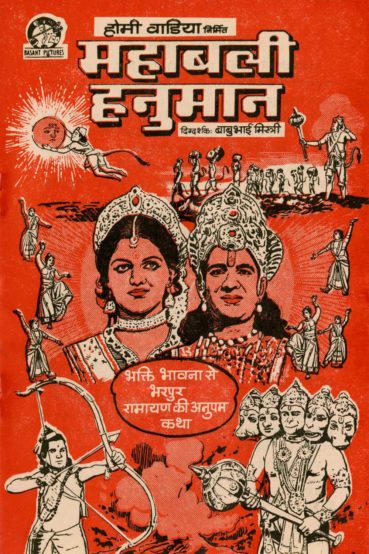
Hindi Devotional madness that’s about average for this sort of thing—which renders it far above average by most every other standard. If nothing else it’s certainly unique, relating the doings of Hindi gods and goddesses via production values and special effects that are straight out of the silent era. But of course those are constants of most all Devotional pictures, of which MAHABALI HANUMAN is, once again, an average example. It’s one of several such features devoted to the monkey god Hanuman, who becomes devoted to serving Rama, the seventh incarnation of the deity Vishnu. Hanuman can do neat things like jump impossibly high distances, fly (in scenes that make the flying effects in the old SUPERMAN TV series look positively high-tech), shape-shift and swallow the sun. How closely his exploits accord with the particulars of the RAMAYANA (from which all this was taken) I can’t say, but they make for a thoroughly entertaining spectacle that, in its culturally specific earnestness, couldn’t possibly be any weirder.
22. A TIME FOR REVENGE (TIEMPO DE REVANCHA)
I picked this one up after a video store clerk warned me about a “deeply disturbing” final scene that he promised would “stay with you forever.” It’s a taut, if painfully obvious and literal-minded, Argentine thriller from the gifted Adolfo Aristarain (ÚLTIMOS DIAS DE LA VICTIMA). The subject is a demolition worker (Federico Luppi) in a copper mine who, looking to blackmail his corrupt superiors, fakes a dynamite accident and pretends he’s lost his facility for speech. Maintaining this ruse turns out to be more difficult than he ever suspected, especially after a colleague who was in on the scam dies and Luppi’s enemies bug his house, leaving him with few options—hence the “deeply disturbing” finale.
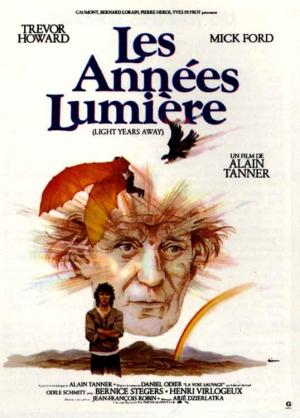 21. LIGHT YEARS AWAY
21. LIGHT YEARS AWAY
A highly eccentric, and highly pictorial, English language drama by France’s Alain Tanner. It stars Trevor Howard as a kooky old man who owns an extremely scenic Irish junkyard overlooking the ocean, and Mick Ford as a drifter who falls under Howard’s spell. Howard has Ford do odd things like man a gas pump that doesn’t work and bury his boss up to his neck in mud (which Howard claims will heal his wounds). Eventually the latter reveals his true object: he wants to fly like a bird, and kills several flora in pursuit of this goal. The film is more compelling than it has any right to be, boasting a succession of well-delineated dissolves to convey the junkyard’s languid aura, and pacing that’s highly deliberate, though never too much so. If the film doesn’t quite work as well as it might have that’s because of Mick Ford’s performance, which is a bit overplayed, and also the final scenes, which close out the proceedings on an overly whimsical note.
20. ALL THINGS PASS (VOORBIJ, VOORBIJ…)
A little known hour-long TV movie from director Paul Verhoeven and screenwriter Gerard Soetman. Both were coming off SOLDIER OF ORANGE, of which this more contained and economical film serves as a footnote of sorts. It’s a well-crafted exploration of the scars left by WWII, in the form of a middle aged veteran of the Dutch resistance (André van den Heuvel) who upon spotting a turncoat comrade (Jan Staal) becomes determined to enact revenge. This entails tracking down four surviving colleagues to assist him, even though they aren’t nearly as gung ho about the gambit as he. Many provocative issues are brought up in the course of this film—is revenge ever truly justified? Does it matter that the intended victim is a crippled old man? Should grudges continue to be held decades after the fact?—which is a bit too talky for my tastes, but pulled off with a great deal of unpretentious suspense.
19. MYSTERY OF THE THIRD PLANET (TAYNA TRETEY PLANETY)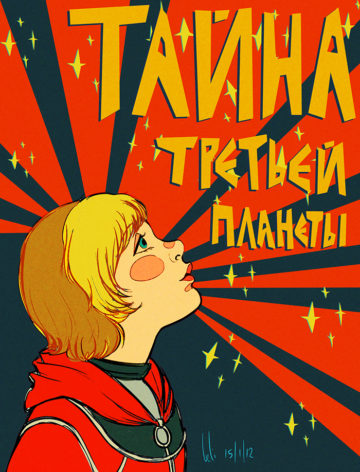
Nifty kid-oriented sci fi animation from Russia’s Soyuzmultfilm and author Kir Bulychev. Adapting a few tales from his celebrated collection ALICE THE GIRL FROM EARTH, Bulychev packs an amazing amount of invention into a 48 minute framework, centered on Alice, a young 22nd century girl accompanying her biologist father on an interstellar journey to find rare animals. Along the way they uncover a dastardly conspiracy and come into contact with a number of nifty imaginary creatures (a flying cow among them). Alice and her father are admittedly not terribly compelling characters, and the animation, which tends to err on the cute (i.e. Disney-esque) side of things, is a mite dated, but Bulychev was in fine form. Watching his near-insanely fertile imagination at work is compensation enough.
18. RHYTHM OF A CRIME (RITAM ZLOCINA)
A most fascinating supernatural drama from Croatia. It concerns a teacher (Ivica Vidovic) who allows a displaced stranger (Fabijan Sovagovic), a highly eccentric old man, to share his home. The latter claims to be able to predict crimes far in advance of their occurrence, accomplished via a highly involved, and quite fascinating, system of numerology. Nearly as interesting is the film’s second half, in which the old man’s carefully considered calculations appear to go wrong, leading to uncertainty and, perhaps, mayhem (how can we be sure Sovagovic isn’t committing the predicted calamities himself?). A consistently provocative work that’s lessened by an overly intellectualized, sensation-free aesthetic, and also the fact that the only available prints are of inexcusably poor quality.
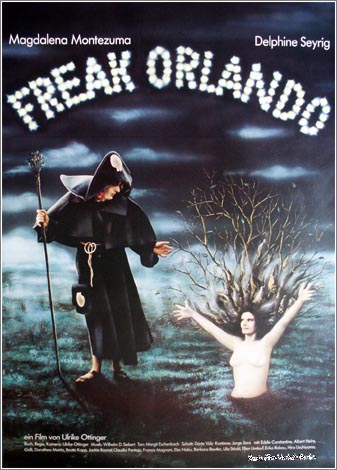 17. FREAK ORLANDO
17. FREAK ORLANDO
From the famed avant-garde painter/filmmaker Ulrike Ottinger comes this beyond-bizarre phantasmagoria. Loosely adapted from Virginia Woolf’s ORLANDO: A BIOGRAPHY, FREAK ORLANDO purports to show “A history of the world from its beginnings to our day, including the errors, the incompetence, the thirst for power, the fear, the madness, the cruelty and the commonplace…” What that description leaves out is the fact that the film is populated solely with human oddities. The main character is “Freak” Orlando (Magdalena Montezuma), a woman who assumes many guises (and changes sex at least once) over the course of five different episodes set in different periods of history, all filmed in and around modern-day Berlin. We see a two-headed woman, endless midgets, spindly weirdies who madly flagellate themselves, a gaggle of amputee dancers and so on. Surrealism is a constant and relentless presence, from a table set entirely with flaming dishes to the sight of a tree-woman who literally grows out of the ground. A full two hours of this is a bit much, but such visionary audacity is rare-to-nonexistent in modern cinema, and deserves our support.
16. KISAPMATA
This thriller is considered a classic of Filipino cinema. I have issues with the overly histrionic performances, awkward camera angles and thuddingly obvious music cues, but director Mike De Leon gets enough things right to make for an impacting film. Inspired by the fact-based story “The House on Zapote Street” by Nick Joaquin (https://www.idealreads.com/the-house-of-zapote-street/), it tells of a young man (Jay Ilagan) who in courting the fetching Milagros (Charo Santos) enters the sanctum of the Carandangs, a family lorded over by an overbearing ex-cop patriarch (Vic Silayan). Unable to accept the betrothal of his daughter, Silayan goes out of his way to make life miserable for the pair, leading to tension, disillusionment and a bloody finale. De Leon gives this bleak drama a highly expressionistic veneer, with a deeply ominous sense of foreboding coloring even the most uneventful scenes, and renders the incest angle, which was only hinted at in the story, quite literal.
15. NIGHT DREAMS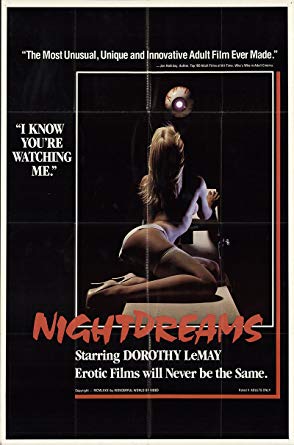
One of the most revolutionary porn films of the 1980s, and an undoubted high point in a format that contains very few. Writer/producer Stephen Sayadian, a.k.a. Rinse Dream, did his best to elevate the XXX industry, as did director Francis Delia and co-writer Jerry Stahl. The “plot” hinges on bored workers in a futuristic sex clinic monitoring the thoughts and fantasies of a severely repressed woman (Dorothy LeMay). They attempt to electronically stimulate her libido, resulting in a succession of bizarre erotic reveries that involve LeMay getting ogled by giant clown heads, manhandled by lesbian cowgirls and ravished by insatiable Arabs. She also tries to seduce a robotic man, but upon unzipping his fly pulls out a dead human fetus, and fellates a guy encased in a giant cream of wheat box. She later wakes up in bed beside a gasping fish, and eventually winds up in Hell. Obviously the narrative–which is really just an excuse for a lot of extended sex scenes—leaves much to be desired, but the artful lighting and evocative sound design are of a quality that’s all-but unheard of in adult moviemaking, and conjure a genuinely eerie and nightmarish atmosphere. There’s also a haunting rendition of “Ring of Fire” by Wall of Voodoo that perfectly underscores the cowgirl sequence.
14. SOLDIER GIRLS
A Nick Broomfield documentary that looks at several women undergoing basic training at a Georgia Army base. It makes for an excellent companion piece to CHICKEN RANCH, Broomfield’s 1983 documentary about the infamous Las Vegas brothel; like that film, SOLDIER GIRLS simply records what it sees sans narration, and refuses to ever take a stand (not at all like Broomfield’s more recent docos, which tend to wear their opinions on their sleeves). We see young women shouted at, humiliated and forced to undergo a number of grueling physical challenges. If the subjects were men I doubt anyone would bat an eyebrow, but since they’re female one can’t help but feel somewhat repulsed by all the abuse. Speaking of repulsive, we’re also shown a sergeant biting the head off a live chicken, ensuring this film a place in the mondo lexicon.
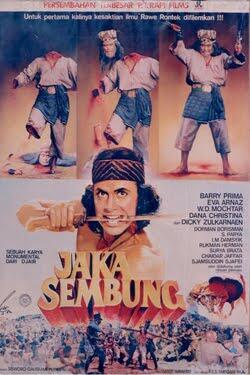 13. THE WARRIOR (JAKA SEMBUNG)
13. THE WARRIOR (JAKA SEMBUNG)
Indonesian movies are usually always a blast, and this martial arts-laden Indo fantasy is a blast and a half. Starring Indonesian legend Barry Prima, THE WARRIOR is set in some past era, in which an Indo country has been taken over by a corrupt warlord, with Prima the revolutionary hero who goes up against the scumbag and his fire-breathing henchman. Prima ends up imprisoned and crucified, has his eyes stabbed out and gets turned into a pig–not to worry, though, because he ultimately prevails. The film’s primary charm is the unapologetic ridiculousness of its action (the Mondo Macabro DVD is horribly dubbed into English, which seems appropriate) and hilariously primitive special effects. It’s my contention that any movie containing flying limbs, floating eyeballs, levitating bodies, mass carnage and multiple animal metamorphoses simply cannot be anything other than a must see.
12. COUP DE TORCHON (CLEAN SLATE)
A French-made adaptation of Jim Thompson’s 1964 pulp masterpiece POP. 1280. The late Bertrand Tavernier (1941-2021) transposes the setting from the American South of the fifties to Africa in the thirties, specifically the French colonies and their grotesque inhabitants, a change that works far better than you might expect. The period detail is impeccable, and Thompson’s darkly comedic tale of corruption and decadence works extremely well in this highly oppressive, racist atmosphere. Unfortunately the film, like most of Tavernier’s work, is bloated, meandering and overlong. Still, Phillipe Noiret, as a wimpy police chief who embarks on a killing spree in order to “wipe the slate clean,” gives what may just be his finest-ever performance, and he’s extremely well supported by Isabelle Huppert and Stephane Audran.
11. VISITORS FROM THE ARKANA GALAXY (GOSTI IZ GALAKSIJE)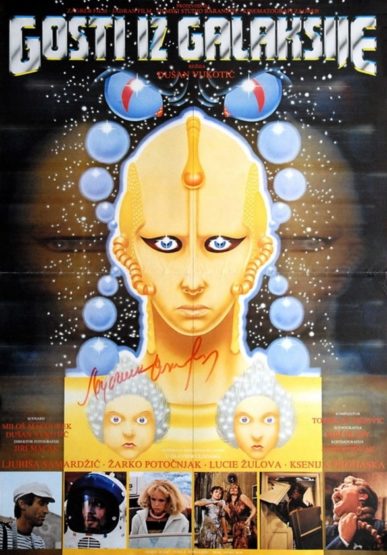
A joint project between two no-longer-extant countries, Yugoslavia and Czechoslovakia, with a script by the latter’s Milos Macourek. If that name is unfamiliar to you it shouldn’t be, as Macourek co-scripted the legendary Czech miniseries ARABELA, whose unique brand of feverish invention is very much on display here. For viewers not keyed in to Macourek’s warped sensibilities VISITORS FROM THE ARKANA GALAXY may seem like puddle-deep quasi-satiric nonsense, but for everyone else it will be an absorbing viewing experience. It begins with a science fiction writer conjuring into existence a family of extraterrestrials with the power to alter reality, and a horrific Jan Svankmajor animated monstrosity in tow. The film builds from there in an outrageous and often twisted succession of events, which climax with the monster embarking on a gory rampage that wouldn’t feel out of place in a Stuart Gordon movie. Deep and socially relevant this film isn’t, but fun it undeniably is.
10. LE SYSTEME DU DOCTEUR GOUDRON ET DU PROFESSEUR PLUME
This well mounted, handsomely visualized 55 minute telefilm debuted as part of a French miniseries consisting of adaptations of Edgar Allan Poe stories. It was directed by the late Claude Chabrol, adapting Poe’s immortal inmates-running-the-asylum tale “The System of Dr. Tarr and Prof. Fether.” Jean-Francois Gerreaud plays a 19th Century everyman who one day decides to check out a secluded insane asylum whose head, one Doctor Maillard (Pierre Le Rumeur), has allegedly created a revolutionary new system for dealing with his inmates. After laying out the particulars of his system the doctor invites Gerreaud to a banquet whose participants behave in an increasingly irrational manner, and act terrified at the sounds emanating from a locked room. Eventually the truth is revealed: Maillard is in fact an inmate who together with his fellows locked up the doctors and took over the asylum. Chabrol and screenwriter Paul Gegauff follow Poe’s text quite closely, and unlike previous adaptations of the story (which include Juan Lopez Moctezuma’s MANSION OF MADNESS and Janusz Majewski’s SYSTEM), add very little of their own outside a perverse coda in which the protagonist runs off with one of the loonies. And while the opening scenes are a bit overly talky, the whole thing rises to a memorable pitch of insanity, and overall must be counted as one of Chabrol’s most interesting films of the 1980s.
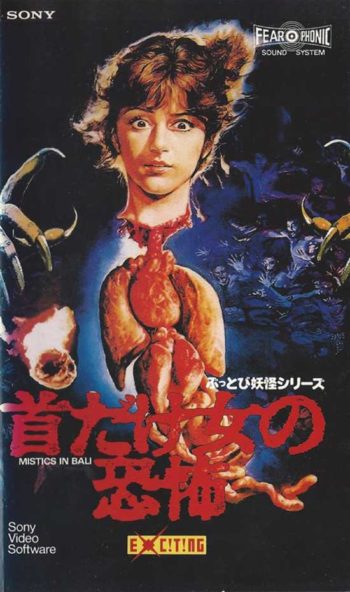 9. MYSTICS IN BALI (LEAK)
9. MYSTICS IN BALI (LEAK)
A pretty astonishing piece of work from Indonesia that’s also cheap, clumsy and unintentionally hilarious. That may be precisely why MYSTICS IN BALI is so much fun, with its succession of wild, near-indescribable images, all of them patterned on Indonesian mythology. They include a woman’s head detaching itself from her body and floating around with its innards attached, people metamorphosing into pigs and snakes, a giant fireball battle, a tattoo affixed via a long forked tongue and the aforementioned flying head devouring an unborn fetus from between its mother’s legs. There’s also the expected psychedelic magic showdown climax, which it seems all Asian horror/fantasy flicks require, and is here pulled off with a great deal of straight-faced brio. As directed by the irrepressible H. Tjut Djalil (of LADY TERMINATOR and DANGEROUS SEDUCTRESS), the whole thing is surprisingly spare and nonshowy (at least in contrast to most South Asian fare), which only serves to accentuate the insanity.
8. UNITED KINGDOM
This bleak and brilliant drama of social strife was the last of several British TV movies directed by Roland Joffé before he decamped to the feature film world (with THE KILLING FIELDS, THE MISSION and a host of lesser films). Scripted by the late Jim Allen, it followed THE SPONGERS (1978), a previous Allen-Joffé TV project that made quite a splash. The similarly themed UNITED KINGDOM is in many respects a superior work, with an epic sweep and more compelling arc. Directed with a spot-on eye for realism and boasting a host of unaffected, artifice-free performances, the pic is set in a working class community whose council is hit with Thatcherian spending cuts but refuses to implement the measures. This leads to a clash that only grows increasingly intense as police are called in to intimidate the citizenry and outdoor barricades are erected. Allan and Joffé are careful to show the human side of political activism and the toll it takes on the participants’ relationships (as in an especially lacerating scene in which a young boy is badgered by police officers into ratting out his shoplifter friends, which in turn leads to a huge row between the kid’s parents). What ultimately registers is the sheer unpleasantness of life in lower class Britain; as one of the characters states near the end, life in prison would probably be a preferable alternative for many of the young folk living in this shithole, and based on what we’re shown I’ll have to agree.
7. THE DEVIL AT YOUR HEELS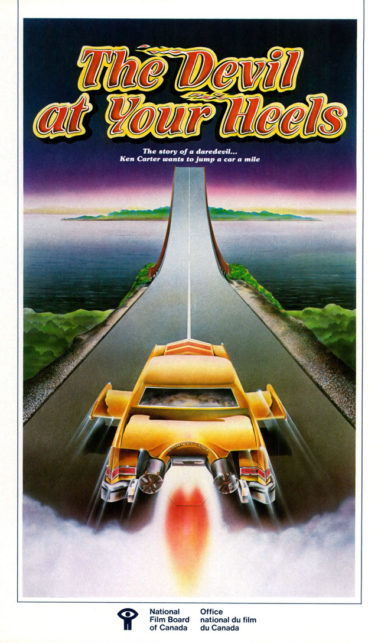
This National Film Board of Canada produced documentary is in the grand tradition of whacked-out Canadian nonfiction cinema (see PROJECT GRIZZLY). It centers on the late Ken Carter, a Montreal stunt driver determined to jump a rocket-fueled car over a stretch of river between Canada and the US, a stunt so dangerous even Evel Knievel called it suicidal. Yet the irrepressible Carter is determined to make the jump, which turns into a five year odyssey fraught with disappointments and false starts. Ultimately Kenny Powers, another stunt driver, ends up attempting the jump, and in so doing demonstrates why it was a bad idea to begin with. Filmmaker Robert Fortier covers this bizarre yet compelling and even inspirational saga from start to nail-biting finish, and does so with enormous skill and economy.
6. SMASH PALACE
A sad, suspenseful and disturbing account of a nasty break-up that remains one of the signature achievements of director Roger Donaldson. Hailing from Donaldson’s homeland of New Zealand, the film was made at the height of the divorce movie craze that gave us KRAMER VS. KRAMER, ORDINARY PEOPLE, SHOOT THE MOON and MY FIRST WIFE. It boasts a superb performance by the late Bruno Lawrence as a more-or-less normal working class father driven ‘round the bend by his cheating wife (Anna Jemison). She takes up with Lawrence’s best friend, upsetting him to no end, and gains custody of his daughter, which gets him even more worked up. But when a bunch of police appointed thugs beat him up Lawrence goes over the edge entirely, kidnapping his little girl and threatening innocent people at gunpoint. Lawrence’s descent into madness is chillingly believable, and complimented by a memorably gritty, naturalistic atmosphere. Plus, the film has a great, and totally unique, score comprised of haunting synthesizer tones by the famed NZ rocker Sharon O’Neill.
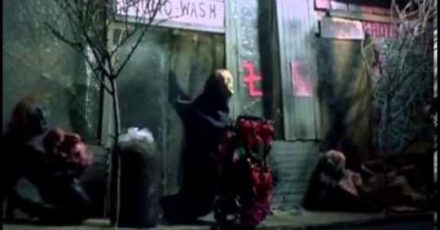 5. NIGHT ON THE TOWN
5. NIGHT ON THE TOWN
A twelve minute animated amazement that remains shockingly little known. It’s a Claymation outrage that plays like, as a review in Shock Cinema magazine proclaimed, “Will Vinton after 23 hits of black acid.” A five year labor of love by Rick Goldstein, NIGHT ON THE TOWN opens with an Edward Much “Scream” faced transient awakening in an outrageously grungy motel room. This is the beginning of a rancid odyssey that involves suicide, a beheading, worms devouring people and subsequently transforming into various objects, a woman impaling herself on a long stick and a man attacked by a chair amid a riot of mutation and dismemberment. Technically the film isn’t quite up to snuff, being notably underlit and featuring stop motion that’s often quite jerky and flickery. But then again, considering the absurdly limited resources faced by Goldstein, NIGHT ON THE TOWN’S full-bodied depiction of an urban inferno is damned impressive (take it from one who’s suffered through many an amateur Claymation opus).
4. MAD FOXES (LOS VIOLADORES)
This German cinemutation is one of the most shameless chunks of crapola you’ll ever see. It’s also irresistible, particularly if you’re in an altered state while viewing it. Robert O’Neal (doubtless an Americanized moniker) plays an irredeemable scumbag who’s first seen trying to seduce a hot chick on her eighteenth birthday. Unfortunately, while driving his Stingray he inadvertently forces a biker off the road, causing the latter’s Nazi buddies to retaliate by kicking the shit out of O’Neal and raping his GF. O’Neal in turn summons a band of Kung Fu enthusiasts who, utilizing some of the most inept Martial Arts techniques you’ll ever see, decimate the bikers, even going so far as to cut off the leader’s penis and stuff it down his throat. Our “hero” then demonstrates his loyalty to his traumatized GF by promptly running off with another woman (snatching her away from her boyfriend, as a matter of fact!). But the bikers are still on the warpath, and brutally slaughter O’Neal’s parents, after which O’Neill, now royally pissed, tracks down and kills his enemies one by one. With its anything-for-a-kick attitude, plentiful sex scenes, ceaseless (though patently fake) gore, nonexistent production values and hideous dubbing, MAD FOXES was and remains an astonishing piece of unadulterated exploitation whose likes will almost certainly never be seen again.
3. KINGS AND DESPERATE MEN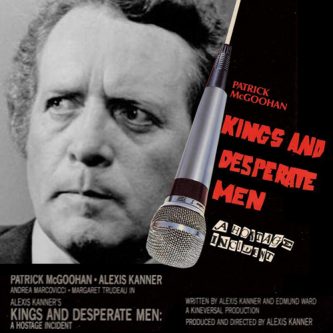
PRISONER fans take note: this 1981 Canadian production reunites the (now deceased) principal actors of that immortal TV series Patrick McGoohan and Alexis Kanner in an arty suspense drama that was co-written, edited, photographed and directed by Mr. Kanner. The barely-released results were initially dismissed, but I say KINGS AND DESPERATE MEN (a longtime favorite of mine, even though I fully recognize its flaws) is interesting enough to warrant a reappraisal. It begins on the night of December 23, when a British radio host (McGoohan) working in Canada is taken hostage in the penthouse suite from which he broadcasts by a militant history professor (Kanner), entailing a very PRISONER-esque face off that only one of them will survive. The production was by all accounts a chaotic free-for-all, which is evident in the choppiness of the finished film, a vastly over-directed hodgepodge with all manner of visual and aural quirks. Yet the film’s raggedness is made to work to its advantage, with the frequent cutaways to the police and citizenry of Quebec coming to rival the dynamic inside the recording studio in sheer intensity. The real drama, of course, is contained in McGoohan’s confrontations with Kanner. Clearly the history these actors shared on THE PRISONER carried over into KINGS AND DESPERATE MEN, and the film is all the more effective for it.
2. DR. JEKYLL AND HIS WOMEN (DR. JEKYLL ET LES FEMMES)
This was the late Walerian Borowczyk’s highly idiosyncratic take on Robert Luis Stevenson’s immortal DR. JEKLL AND MR. HYDE, a profoundly eerie and poetic piece of work that may be Borowczyk’s masterpiece. The film is a largely faithful adaptation of Stevenson’s text, but with one added element: a servant girl named Fanny, inspired by Stevenson’s wife. Jekyll is played by Udo Kier, who after immersing himself in a bathtub filled with a blood-red potion emerges from the water as Mr. Hyde (Gerard Zalcberg), a creep with slicked-back hair and shaved-off eyebrows. His depraved antics cause a frenzy among Jekyll’s guests, most notably Fanny, who after spying on her master in the bath jumps into the water with Jekyll, and embarks on a rampage of joyous debauchery. In the manner of most Borowczyk films the film is put together in extremely choppy and haphazard fashion. The focus is on the fetishistic visuals, and the images are as strange and beautiful as any Borowczyk ever created, enhanced by the burnished sheen of cinematographer Noel Very and the ominous synthesizer music of Bernard Parmegiani. The final scenes, in which Hyde and Fanny embark on their apocalyptic rampage, are stunning, with the already-overheated, dreamlike atmosphere giving way to a veritable orgy of unfettered delirium.
 1. ATRAPADOS
1. ATRAPADOS
This mind-expanding apocalyptic parable is one of the world’s great unknown cult films. It was a labor of love for its screenwriter and lead actor Julio Torresoto, who in the course of the film goes from chubby to alarmingly gaunt, and director Matthew Patrick (HIDER IN THE HOUSE), whose first feature this was. ATRAPADOS was an American production lensed mostly in New York, yet the spoken language is Spanish, making it a “foreign” film; as such it got a fair amount of traction on the early-1980s festival circuit, but is now inexplicably forgotten. The setting is a basement apartment owned by a demure woman (Sonia Vivas), where she and a slob plumber (Torresoto) become trapped by some unspecified catastrophe. In this lightless environment the two are assailed by hallucinations and memories of their former lives while attempting to find some common ground. The proceedings are deeply hallucinatory yet also quite lucid in their approach (not unlike a coherent ERASERHEAD), yet the film’s most striking element is one of its most simple: the use of tinted black-and-white visuals for the basement sequences, which succeed in creating a genuinely otherworldly psychoscape through varying hues of darkness. A few scenes don’t work (such as Torresoto fantasizing about running around the streets of NYC trying to warn people that they too can become trapped), but they don’t detract from the film’s haunting power, which remains distinct and unprecedented.
